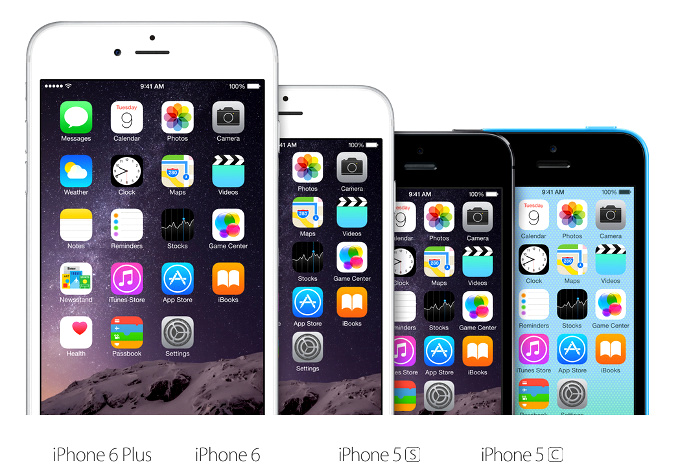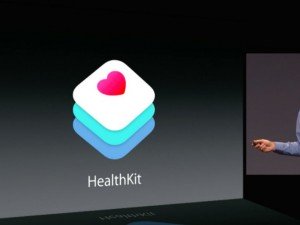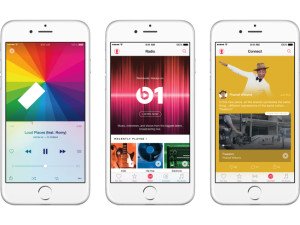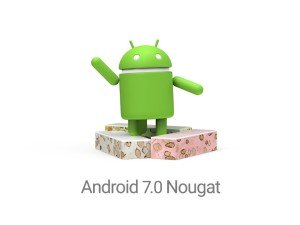
Tim Cook took the stage in Cupertino, California on Tuesday to announce Apple’s newest gadgets. True to recent speculations, Apple has come out with the bigger but thinner iPhone 6, offered up variety with the phablet-sized iPhone 6 Plus, and entered as a strong contender in the wearables game with the Apple Watch.
And while the internet has been rife with either Android user criticisms or the emphatic excitement that’s typical of loyal Apple fans, we’ve been paying close attention to the ways that Apple’s newest iteration of the iPhone will improve user experience and create new opportunities for iOS developers. But first, let’s compare the new to the old with some data offered up by ZDnet:
| iPhone 6 Plus | iPhone 6 | iPhone 5s | iPhone 5c | |
| Dimensions HxWxD (mm) |
158.1 x 77.8 x 7.1 | 138.1 x 67.0 x 6.9 | 123.8 x 58.6 x 7.6 | 124.4 x 59.2 x 8.97 |
| Weight (g) | 172 | 129 | 112 | 132 |
| Display size | 5.5-inch | 4.7-inch | 4-inch | 4-inch |
| Resolution | 1920 x 1080 | 1334 x 750 | 1136 x 640 | 1136 x 640 |
| Pixels per inch | 401 | 326 | 326 | 326 |
| Contrast ratio | 1300:1 | 1400:1 | 800:1 | 800:1 |
| Processor | 64-bit A8 | 64-bit A8 | 64-bit A7 | A6 |
| Motion coprocessor | M8 | M8 | M7 | N/A |
| Original storage capacities (GB) | 16/64/128 | 16/64/128 | 16/32/64 | 8/16/32 |
| Wi-fi | 802.11a/b/g/n/ac | 802.11a/b/g/n/ac | 802.11a/b/g/n | 802.11a/b/g/n |
| Bluetooth | Bluetooth 4.0 | Bluetooth 4.0 | Bluetooth 4.0 | Bluetooth 4.0 |
| iSight camera | Updated 8-megapixel iSight camera with 1.5µ pixels, f/2.2, and optical image stabilization | Updated 8-megapixel iSight camera with 1.5µ pixels, f/2.2 | 8-megapixel iSight camera with 1.5µ pixels, f/2.2 | 8-megapixel iSight camera, f/2.4 |
| Flash | True Tone | True Tone | True Tone | LED |
| Facetime camera | 1.2-megapixel photos (1280 by 960), 720p HD, f/2.2, with burst mode and auto HDR for photos and video | 1.2-megapixel photos (1280 by 960), 720p HD, f/2.2, with burst mode and auto HDR for photos and video | 1.2-megapixel photos (1280 by 960), 720p HD, f/2.4, with auto HDR for photos | 1.2-megapixel photos (1280 by 960), 720p HD, f/2.4 |
| Video | 1080p HD video recording at 30 fps or 60 fps |
1080p HD video recording at 30 fps or 60 fps |
1080p HD video recording at 30 fps) |
1080p HD video recording at 30 fps |
| Slo-mo | Slo-mo video at 120 fps or 240 fps | Slo-mo video at 120 fps or 240 fps | Slo-mo video at 120 fps | N/A |
| Talk time | Up to 24 hours on 3G | Up to 14 hours on 3G | Up to 10 hours on 3G | Up to 10 hours on 3G |
| Standby | Up to 16 days | Up to 10 days | Up to 10 days | Up to 10 days |
| Internet | Up to 12 hours on 3G, up to 12 hours on LTE, up to 12 hours on Wi-Fi | Up to 10 hours on 3G, up to 10 hours on LTE, up to 11 hours on Wi-Fi | Up to 8 hours on 3G, up to 10 hours on LTE, up to 10 hours on Wi-Fi | Up to 8 hours on 3G, up to 10 hours on LTE, up to 10 hours on Wi-Fi |
| Video/Audio playback (hours) | 14/80 | 11/50 | 10/40 | 10/40 |
| Sensors | Barometer 3-axis gyro Touch ID Accelerometer Proximity sensor Ambient light sensor Digital compass |
Barometer 3-axis gyro Touch ID Accelerometer Proximity sensor Ambient light sensor Digital compass |
3-axis gyro Touch ID Accelerometer Proximity sensor Ambient light sensor Digital compass |
3-axis gyro Accelerometer Proximity sensor Ambient light sensor Digital compass |
| Colors | Space gray Silver Gold |
Space gray Silver Gold |
Space gray Silver Gold |
White Yellow Blue Red Green |
Great. So what does it all mean?
The iPhone 6 and 6 Plus will be equipped with more processing power (with the A8 chip and M8 motion coprocessor) and a higher resolution screen. And while these specs make the biggest impact for iOS game developers (as anyone who watched the September 9th event saw, with the demonstration of Vainglory), it’s ultimately going to result in a better performance for any graphics-heavy iOS apps.
Additionally, the larger screens mean more app “real estate.” Landscape in the 6 Plus offers a two-panel view feature for iMessage and Email, which will translate nicely for any content-heavy apps. Also unique to the iPhone 6 Plus is Apple’s new optical image stabilization, which, according to Apple’s Phil Schiller, means that the iPhone can function like a high-end DSLR. Don’t believe us? Ask Wired.
The most important change of note, however, is the fact that iPhone 6 and 6 Plus will operate on iOS 8, the newest iteration of Apple’s iPhone software that brings with it a lot of big changes. New APIs like HealthKit, PhotoKit, Touch ID and CloudKit (which are just 4 of 4,000) create tons of new functionalities that leverage the new iPhone’s sensors and full iCloud integration. And if software upgrade statistics of the past ring true, then developers will have no problem bringing their apps’ new functionalities to a broad market almost immediately, with Apple users being historically quite diligent in their OS upgrades, whether they’ve purchased the new hardware or not.
So what does this mean for your app? Get in touch with us today to receive an iOS 8 evaluation.





